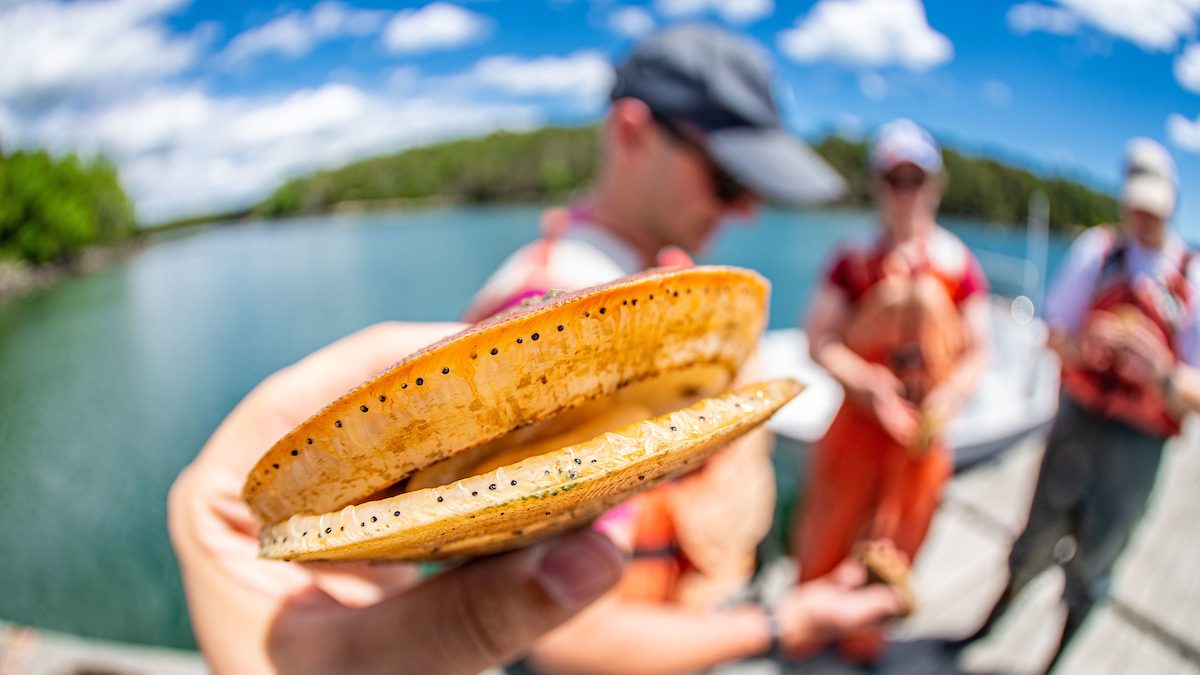
UMaine study reveals how to turn the tide on scallop-rearing challenges
by Erin Miller
Atlantic sea scallops, Placopecten magellanicus, are among the most valuable shellfish in New England. According to the National Oceanic and Atmospheric Administration (NOAA), commercial landings were valued at $478 million in 2022. Atlantic scallops were Maine’s fifth most valuable fishery that year.
The burgeoning industry offers great promise for working waterfronts, but scallop hatcheries are hindered by a key production challenge—the current industry standard for survival to maturity is just one percent. To find out why, a state-wide research consortium coordinated by the Maine Aquaculture Innovation Center based at UMaine’s Darling Marine Center, and supported by NOAA Sea Grant was established to study hatchery practices, scallop biology and scallop microbiology.
The study led by Suzanne Ishaq, assistant professor of animal and veterinary sciences at the University of Maine, found that scallop growers seeking solutions may need to look to the moon, or rather, its influence over tides and the pathogens they carry. The microbiology research team also included scientists and students from across UMaine, as well as the University of Maine at Machias, Downeast Institute, and the University of Southern Maine. They collaborated with hatcheries to study how microbes interact with scallops in wild and hatchery settings. The research may ultimately help standardize management practices that support communities of beneficial microbes to improve animal health and enhance the success of cultured scallop production.
The final two weeks of the free-floating, larval, phase of sea scallop rearing is plagued by mass mortality—60 million larvae often dwindle to a few thousand in just two days. Previous studies have helped hatcheries fine-tune the optimal diet, lighting, temperature and atmospheric pressure for growing scallops. Studies focused on the pathogens that may cause these die-offs are more limited and focused on specific disease-causing microbes. Scallop hatcheries, aware of these risks, meticulously filter and sterilize seawater for their hatcheries and flush the systems every other day. Despite their efforts, bacteria abound, although that may not be a bad thing.
The research team characterized the bacterial communities—a first for scallops—that grow in biofilms coating hatchery tank surfaces, as well as in scallop eggs and larvae in hatchery and wild settings.
“There is so much we don’t know about scallops,” Ishaq says. “Do they need bacteria to help them fight pathogens or digest food? Do they need specific bacteria, or will any of them do? Which bacteria do wild scallops have, and how do scallops in hatcheries compare?”
The study documented a cyclical rise and fall of the bacterial richness, or species diversity, in biofilms that correlated with the lunar cycle and corresponding shifts in the tides. Bacterial richness peaked when the moon was roughly half-full and dropped during the new and full moon when tides were highest. Higher tides can increase connectivity between oceans, estuaries, and particles flowing from land, including those from human activity. Although the team did not measure water runoff, the changes observed suggest that this influx upends the bacterial community in scallop tanks, making it easier for pathogens to survive. The study also found that wild scallop eggs and larvae host more bacterial species than their hatchery-raised counterparts, which could mean those growing in tanks lack the beneficial bacteria they need to survive. No significant difference in the diversity of bacterial richness between clean and dirty tanks, or the mechanism for water flow, was noted.
These findings are the first step toward new methods that may increase the survival rate of larval scallops. Based on these results, hatcheries may wish to avoid collecting seawater when tides are highest to promote more diverse microbial communities that can provide a line of resistance to harmful pathogens. They likely would also benefit from additional filtration systems to remove bacteria that can harm growing scallops.
In addition to Ishaq, the UMaine members of the research team included Damian Brady, professor of oceanography, Jennifer Perry, associate professor of food microbiology, Timothy Bowden, associate professor of aquaculture, and Erin Grey, assistant professor of biology. Sarah Hosler, Phoebe Jekielek, and Adwoa Dankwa, who were all University of Maine graduate students during the study, were also coauthors. Dankwa is now a postdoctoral researcher in Perry’s lab. Brian Beal professor of marine ecology at the University of Maine at Machias, Kyle Pepperman, associate director of technology transfer at the Downeast Institute; and University of Southern Maine (USM) Associate Professor of Biology Rachel Lasley-Rasher and Hannah Haskell, a USM biology student, also contributed to the study.
The study was published in the October 2023 issue of Aquaculture Reports. The project was supported by the USDA National Institute of Food and Agriculture through the Maine Agricultural and Forest Experiment Station (Bowden, ME0-22309; Ishaq, ME0-22102; Perry, ME0-21915), the National Science Foundation through Maine EPSCoR’s Maine Center for Genetics and the Environment (Grey, #OIA-1849227), the Maine Food and Agriculture Center and the Maine Economic Improvement Fund.
Contact: Erin Miller, erin.miller@maine.edu
